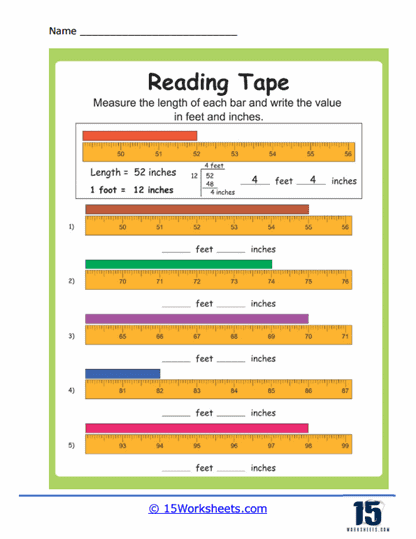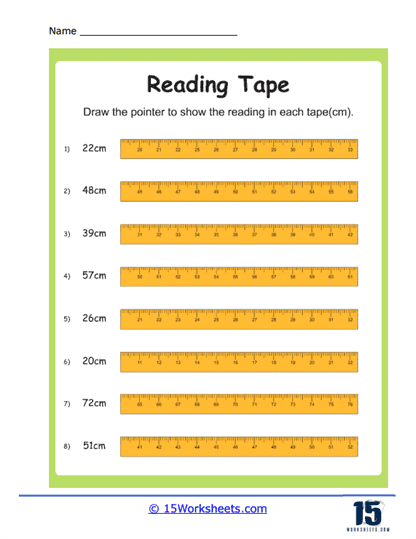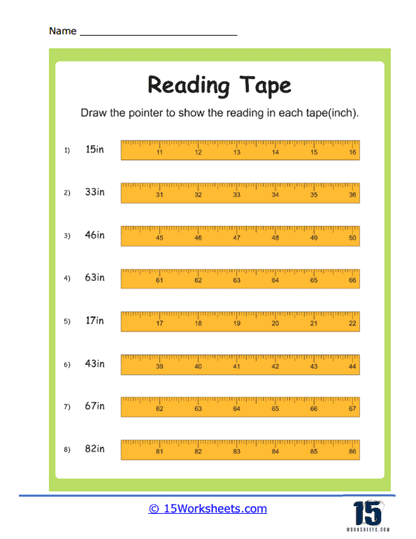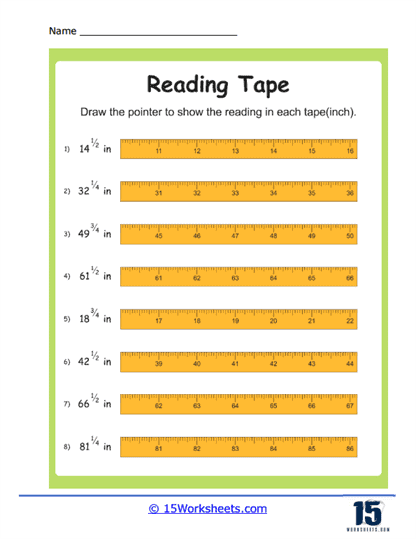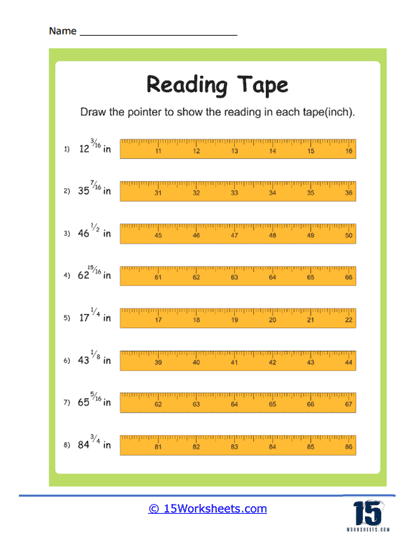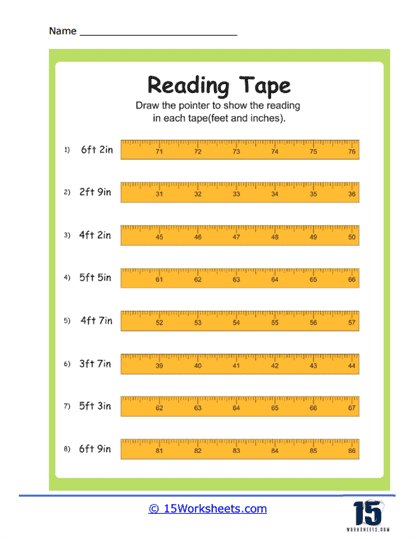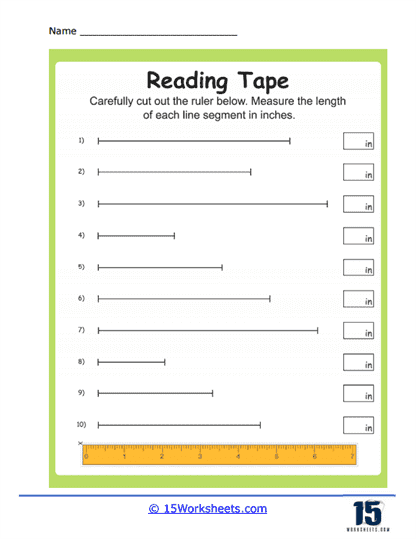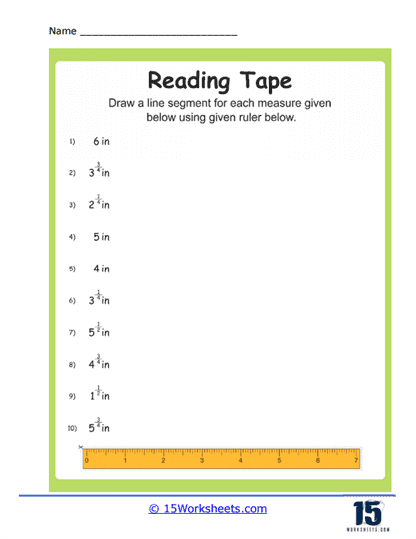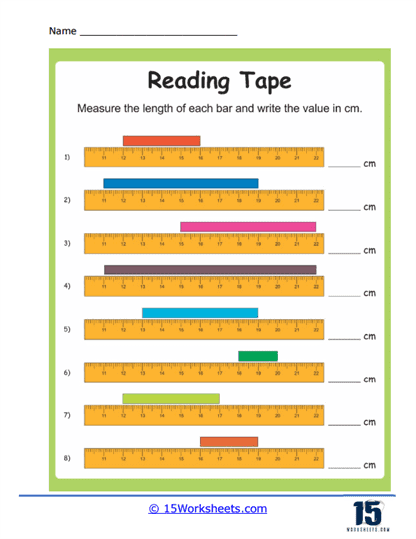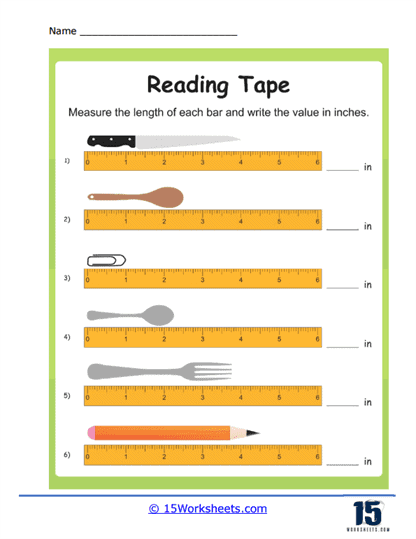Reading Tape Measures Worksheets
About These 15 Worksheets
Precision in measurement is not just a technical skill; it is a fundamental aspect of numerous professions and activities that touch our daily lives. Whether in construction, where exact measurements ensure the structural integrity of buildings, or in tailoring, where a fraction of an inch can make the difference between a perfect fit and an ill-fitting garment, accuracy is critical. Even in seemingly simple DIY home projects, where one might be hanging a picture frame or assembling furniture, the ability to measure precisely is the difference between success and frustration. Among the myriad tools available for these tasks, the tape measure stands out for its practicality and versatility. Its design allows for quick and accurate measurements in a wide range of contexts, making it indispensable across professions and households alike. Understanding how to use a tape measure effectively is a skill that is foundational yet often overlooked, and it is one that can empower individuals to approach any measurement task with confidence and precision.
To bridge this gap in understanding, the worksheets provided here have been meticulously designed to ensure that learners, whether students in a classroom or individuals honing their practical skills, fully grasp the intricacies of using a tape measure. The goal is not merely to familiarize users with the tool, but to cultivate a deep understanding of its various components, markings, and scales. While a tape measure may appear simple at first glance, the array of lines representing fractions of an inch or centimeter can become confusing, particularly for beginners. These worksheets demystify this complexity by breaking down the process of reading and interpreting the markings in a clear, step-by-step manner. Through guided exercises, learners are able to progress from basic concepts to more advanced measurement tasks, building both confidence and competence along the way.
The structure of these worksheets is designed with the learner’s journey in mind. Each worksheet begins with fundamental concepts, such as recognizing whole numbers and fractional increments on the tape measure. From there, learners are introduced to more detailed aspects, such as differentiating between metric and imperial systems, and understanding how to convert between units when necessary. This sequential approach ensures that learners are not overwhelmed by information, but instead are guided through a logical progression that mirrors the way professionals approach measurement tasks. By providing real-world examples and practical exercises, the worksheets make abstract concepts tangible, allowing learners to apply what they have learned to actual scenarios they may encounter in their personal or professional lives.
Types of Exercises
Identifying Parts of a Tape Measure – Before diving deep, students first get acquainted with the various parts of a tape measure, such as the casing, blade, hook, and different scale markings. This can help familiarize students with the components of a tape measure to lay a foundational understanding.
Reading Basic Measurements – Initial exercises usually involve reading straightforward measurements. For instance, identifying the measurement that a specific marking corresponds to. This can help kids begin to develop basic proficiency in interpreting the larger, more obvious divisions on the tape measure, such as inches or centimeters.
Understanding Fractions on a Tape Measure – Tape measures, especially those using the imperial system, have fractional divisions. Exercises might focus on reading 1/4, 1/8, 1/16, or even 1/32 inch markings. This task can help equip students with the skills to understand fractional divisions on a tape measure, crucial for tasks requiring precision.
Estimating Measurements – Students might be asked to estimate the length of an object before measuring it, honing their intuition and observational skills. This can help students begin to cultivate an intuitive sense for length and distance, refining estimation abilities.
Comparing Lengths – Two or more measurements are presented, and students are tasked with determining which is longer or shorter, or by how much. By engaging in these tasks students can enhance their analytical skills and deepen comprehension of relative lengths.
Converting Measurements – Exercises can challenge students to convert measurements between units, such as from inches to feet or centimeters to meters. This helps students reinforce their understanding that relationships that exist between different units of measurement and improve mathematical dexterity.
Practical Measurement Scenarios – Students encounter real-world situations where they need to measure objects or distances, offering context to the importance of accurate measurements. This will show students the practical applications of using tape measures in various real-life situations.
What Do These Worksheets Teach Students?
Instrument Familiarity
At the most fundamental level, these worksheets are designed to introduce students to the tape measure—a tool many may have seen but not fully understood. By breaking down the tape measure into its core components, the worksheets aim to familiarize students with every detail, from the numbered marks to the spaces between, and explain what each represents. This initial exposure ensures that students don’t just view the tape measure as a generic tool but understand its purpose and how to read it accurately. Knowing how to distinguish between the inches, fractions, and sometimes metric markings on a tape measure is an essential skill, as it lays the groundwork for understanding more complex measurement tasks in the future. By demystifying this tool, students are empowered to approach measurement tasks with confidence and competence.
Precision in Measurement
One of the critical aspects these worksheets focus on is the concept of precision. Accurate measurement is more than just reading a number; it involves understanding the divisions within those numbers, especially when working with fractions of an inch or centimeter. By concentrating on both the larger, more obvious divisions and the smaller fractional ones, students are encouraged to think about the importance of every increment. This focus on detail helps students recognize that even a small discrepancy can lead to significant errors, particularly in fields such as construction, engineering, or fashion design, where precise measurements are crucial. This attention to detail fosters a sense of responsibility in students, teaching them the value of accuracy in both academic and real-world contexts.
Estimation Skills
Beyond the ability to measure with a tool, these worksheets encourage students to hone their estimation skills. Estimation involves making an educated guess about the length or distance of an object without immediately resorting to a measuring device. This is a valuable skill in situations where tools aren’t readily available, but it also sharpens a student’s ability to gauge and reason about space and dimension. Estimation bridges the gap between rough approximation and exact measurement, teaching students how to approach a problem from multiple angles. It’s particularly useful in everyday situations-whether determining if a piece of furniture will fit in a room or estimating the length of material needed for a project-giving students practical skills they can apply both in and out of the classroom.
Unit Comprehension
Another core learning objective embedded within these worksheets is the comprehension of different units of measurement. Understanding inches, feet, centimeters, and millimeters, and knowing how to convert between these units is vital for students to have a well-rounded grasp of the subject. The exercises encourage students to not only recognize the different units but also develop an intuitive understanding of their relationships—how many inches are in a foot, or how centimeters relate to meters, for example. Mastery of these conversions is not only essential for tasks involving a tape measure but is also a foundational mathematical skill that students will carry forward into more complex areas of study, such as geometry, physics, and even chemistry.
Real-world Application
What makes these worksheets particularly valuable is their grounding in real-world applications. Students aren’t just learning to use a tape measure in a theoretical sense; they’re exposed to practical scenarios that show how these skills are directly applicable to everyday life. Whether it’s measuring fabric for a design project, ensuring the right dimensions for a piece of wood in carpentry, or simply hanging a picture at the correct height, these exercises demonstrate that the ability to measure accurately is a life skill. By contextualizing measurement within practical tasks, students begin to appreciate its relevance beyond the classroom, understanding that the ability to read a tape measure effectively can apply to numerous careers and hobbies.
Analytical Thinking
In addition to teaching measurement skills, these worksheets promote analytical thinking. Exercises that involve comparing lengths, determining differences between measurements, or solving word problems based on real-world scenarios encourage students to think critically. They must evaluate the information given, break it down into manageable parts, and apply their measurement knowledge to find solutions. This process enhances their problem-solving abilities, requiring them to not only understand measurement as a concept but to apply it in ways that involve logical reasoning and analytical precision. As they navigate these problems, students develop a deeper understanding of how measurements can be used in conjunction with broader mathematical principles.
These worksheets provide a thorough and engaging approach to teaching students how to read and use a tape measure. They offer a bridge between the abstract world of mathematical concepts and the concrete, practical applications of those concepts in everyday life. Through activities that emphasize instrument familiarity, precision, estimation, and real-world application, students are encouraged to develop both technical skills and critical thinking abilities. As they progress, they gain an appreciation for the precision required in measurement and an understanding of its wide-ranging importance, whether in school projects, future careers, or household tasks. Ultimately, these worksheets are more than just exercises-they are a stepping stone toward mastery in a vital, lifelong skill.





